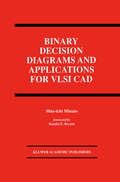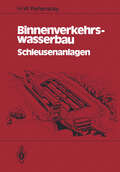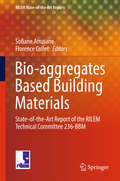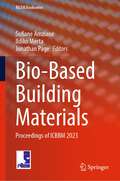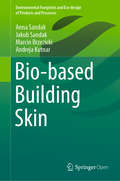- Table View
- List View
Binary Decision Diagrams: Theory and Implementation
by Rolf Drechsler Bernd BeckerFor someone with a hammer the whole world looks like a nail. Within the last 10-13 years Binar·y Decision Diagmms (BDDs) have become the state-of-the-art data structure in VLSI CAD for representation and ma nipulation of Boolean functions. Today, BDDs are widely used and in the meantime have also been integrated in commercial tools, especially in the area of verijication and synthesis. The interest in BDDs results from the fact that the data structure is generally accepted as providing a good compromise between conciseness of representation and efficiency of manipulation. With increasing number of applications, also in non CAD areas, classical methods to handle BDDs are being improved and new questions and problems evolve and have to be solved. The book should help the reader who is not familiar with BDDs (or DDs in general) to get a quick start. On the other hand it will discuss several new aspects of BDDs, e.g. with respect to minimization and implementation of a package. This will help people working with BDDs (in industry or academia) to keep informed about recent developments in this area.
Binary Decision Diagrams and Applications for VLSI CAD (The Springer International Series in Engineering and Computer Science #342)
by Shin-ichi MinatoSymbolic Boolean manipulation using binary decision diagrams (BDDs) has been successfully applied to a wide variety of tasks, particularly in very large scale integration (VLSI) computer-aided design (CAD). The concept of decision graphs as an abstract representation of Boolean functions dates back to the early work by Lee and Akers. In the last ten years, BDDs have found widespread use as a concrete data structure for symbolic Boolean manipulation. With BDDs, functions can be constructed, manipulated, and compared by simple and efficient graph algorithms. Since Boolean functions can represent not just digital circuit functions, but also such mathematical domains as sets and relations, a wide variety of CAD problems can be solved using BDDs. `Binary Decision Diagrams and Applications for VLSI CAD provides valuable information for both those who are new to BDDs as well as to long time aficionados.' -from the Foreword by Randal E. Bryant. `Over the past ten years ... BDDs have attracted the attention of many researchers because of their suitability for representing Boolean functions. They are now widely used in many practical VLSI CAD systems. ... this book can serve as an introduction to BDD techniques and ... it presents several new ideas on BDDs and their applications. ... many computer scientists and engineers will be interested in this book since Boolean function manipulation is a fundamental technique not only in digital system design but also in exploring various problems in computer science.' - from the Preface by Shin-ichi Minato.
Binary Decision Diagrams and Extensions for System Reliability Analysis (Performability Engineering Series)
by Liudong Xing Suprasad V. AmariRecent advances in science and technology have made modern computing and engineering systems more powerful and sophisticated than ever. The increasing complexity and scale imply that system reliability problems not only continue to be a challenge but also require more efficient models and solutions. This is the first book systematically covering the state-of-the-art binary decision diagrams and their extended models, which can provide efficient and exact solutions to reliability analysis of large and complex systems. The book provides both basic concepts and detailed algorithms for modelling and evaluating reliability of a wide range of complex systems, such as multi-state systems, phased-mission systems, fault-tolerant systems with imperfect fault coverage, systems with common-cause failures, systems with disjoint failures, and systems with functional dependent failures. These types of systems abound in safety-critical or mission-critical applications such as aerospace, circuits, power systems, medical systems, telecommunication systems, transmission systems, traffic light systems, data storage systems, and etc. The book provides both small-scale illustrative examples and large-scale benchmark examples to demonstrate broad applications and advantages of different decision diagrams based methods for complex system reliability analysis. Other measures including component importance and failure frequency are also covered. A rich set of references is cited in the book, providing helpful resources for readers to pursue further research and study of the topics. The target audience of the book is reliability and safety engineers or researchers. The book can serve as a textbook on system reliability analysis. It can also serve as a tutorial and reference book on decision diagrams, multi-state systems, phased-mission systems, and imperfect fault coverage models.
Binary Decision Diagrams and Extensions for System Reliability Analysis (Performability Engineering Series)
by Liudong Xing Suprasad V. AmariRecent advances in science and technology have made modern computing and engineering systems more powerful and sophisticated than ever. The increasing complexity and scale imply that system reliability problems not only continue to be a challenge but also require more efficient models and solutions. This is the first book systematically covering the state-of-the-art binary decision diagrams and their extended models, which can provide efficient and exact solutions to reliability analysis of large and complex systems. The book provides both basic concepts and detailed algorithms for modelling and evaluating reliability of a wide range of complex systems, such as multi-state systems, phased-mission systems, fault-tolerant systems with imperfect fault coverage, systems with common-cause failures, systems with disjoint failures, and systems with functional dependent failures. These types of systems abound in safety-critical or mission-critical applications such as aerospace, circuits, power systems, medical systems, telecommunication systems, transmission systems, traffic light systems, data storage systems, and etc. The book provides both small-scale illustrative examples and large-scale benchmark examples to demonstrate broad applications and advantages of different decision diagrams based methods for complex system reliability analysis. Other measures including component importance and failure frequency are also covered. A rich set of references is cited in the book, providing helpful resources for readers to pursue further research and study of the topics. The target audience of the book is reliability and safety engineers or researchers. The book can serve as a textbook on system reliability analysis. It can also serve as a tutorial and reference book on decision diagrams, multi-state systems, phased-mission systems, and imperfect fault coverage models.
The Binocular Handbook: Function, Performance and Evaluation of Binoculars
by Holger MerlitzThis book is a comprehensive technical treatise on binoculars as visual optical instruments. The author begins by discussing the function of binoculars and the properties of human visual perception. Theoretical models for the synthesis of binoculars and the complex interplay of the different components of binoculars are described. Subsequently, the performance limits, as experienced by the observer in a variety of external conditions, are derived. In the concluding section, the book takes the reader outdoors, where they learn to evaluate the properties and limitations of their binoculars in the field, and to recognize possible problems that may be due to manufacturing errors or accidental damages. Thus, a level of knowledge is provided that will enable the reader to fully exploit the capacities of their binoculars. This book is written for those who work professionally with binoculars and are technically interested, but it is equally useful for professional staff working in the optical industry and the distribution of optical instruments. It includes recent discoveries and is easily accessible to anyone who is seriously interested in learning about binocular function. High school level math is useful to understand the derivations, but not needed to comprehend the results, which are discussed and displayed graphically.
Bio-aggregate-based Building Materials: Applications to Hemp Concretes (Rilem State-of-the-art Reports #23)
by Sofiane Amziane Laurent ArnaudUsing plant material as raw materials for construction is a relatively recent and original topic of research. This book presents an overview of the current knowledge on the material properties and environmental impact of construction materials made from plant particles, which are renewable, recyclable and easily available. It focuses on particles and as well on fibers issued from hemp plant, as well as discussing hemp concretes. The book begins by setting the environmental, economic and social context of agro-concretes, before discussing the nature of plant-based aggregates and binders. The formulation, implementation and mechanical behavior of such building materials are the subject of the following chapters. The focus is then put upon the hygrothermal behavior and acoustical properties of hempcrete, followed by the use of plant-based concretes in structures. The book concludes with the study of life-cycle analysis (LCA) of the environmental characteristics of a banked hempcrete wall on a wooden skeleton. Contents 1. Environmental, Economic and Social Context of Agro-Concretes, Vincent Nozahic and Sofiane Amziane. 2. Characterization of Plant-Based Aggregates. Vincent Picandet. 3. Binders, Gilles Escadeillas, Camille Magniont, Sofiane Amziane and Vincent Nozahic. 4. Formulation and Implementation, Christophe Lanos, Florence Collet, Gérard Lenain and Yves Hustache. 5. Mechanical Behavior, Laurent Arnaud, Sofiane Amziane, Vincent Nozahic and Etienne Gourlay. 6. Hygrothermal Behavior of Hempcrete, Laurent Arnaud, Driss Samri and Étienne Gourlay. 7. Acoustical Properties of Hemp Concretes, Philippe Glé, Emmanuel Gourdon and Laurent Arnaud. 8. Plant-Based Concretes in Structures: Structural Aspect – Addition of a Wooden Support to Absorb the Strain, Philippe Munoz and Didier Pipet. 9. Examination of the Environmental Characteristics of a Banked Hempcrete Wall on a Wooden Skeleton, by Lifecycle Analysis: Feedback on the LCA Experiment from 2005, Marie-Pierre Boutin and Cyril Flamin. About the Authors Sofiane Amziane is Professor and head of the Civil Engineering department at POLYTECH Clermont-Ferrand in France. He is also in charge of the research program dealing with bio-based building materials at Blaise Pascal University (Institut Pascal, Clermont Ferrand, France). He is the secretary of the RILEM Technical Committee 236-BBM dealing with bio-based building materials and the author or co-author of over one hundred papers in scientific journals such as Cement and Concrete Research, Composite Structures or Construction Building Materials as well as international conferences. Laurent Arnaud is a Bridges, Waters and Forestry Engineer (Ingénieur des Ponts, Eaux et Forêts) and researcher at Joseph Fourier University in Grenoble, France. He is also Professor at ENTPE (Ecole Nationale des Travaux Publics de l’Etat). Trained in the field of mechanical engineering, his research has been directed toward the characterization and development of new materials for civil engineering and construction. He is head of the international committee at RILEM – BBM, as well as the author of more than one hundred publications, and holder of an international invention patent.
Bio-aggregate-based Building Materials: Applications to Hemp Concretes
by Sofiane Amziane Laurent ArnaudUsing plant material as raw materials for construction is a relatively recent and original topic of research. This book presents an overview of the current knowledge on the material properties and environmental impact of construction materials made from plant particles, which are renewable, recyclable and easily available. It focuses on particles and as well on fibers issued from hemp plant, as well as discussing hemp concretes. The book begins by setting the environmental, economic and social context of agro-concretes, before discussing the nature of plant-based aggregates and binders. The formulation, implementation and mechanical behavior of such building materials are the subject of the following chapters. The focus is then put upon the hygrothermal behavior and acoustical properties of hempcrete, followed by the use of plant-based concretes in structures. The book concludes with the study of life-cycle analysis (LCA) of the environmental characteristics of a banked hempcrete wall on a wooden skeleton. Contents 1. Environmental, Economic and Social Context of Agro-Concretes, Vincent Nozahic and Sofiane Amziane. 2. Characterization of Plant-Based Aggregates. Vincent Picandet. 3. Binders, Gilles Escadeillas, Camille Magniont, Sofiane Amziane and Vincent Nozahic. 4. Formulation and Implementation, Christophe Lanos, Florence Collet, Gérard Lenain and Yves Hustache. 5. Mechanical Behavior, Laurent Arnaud, Sofiane Amziane, Vincent Nozahic and Etienne Gourlay. 6. Hygrothermal Behavior of Hempcrete, Laurent Arnaud, Driss Samri and Étienne Gourlay. 7. Acoustical Properties of Hemp Concretes, Philippe Glé, Emmanuel Gourdon and Laurent Arnaud. 8. Plant-Based Concretes in Structures: Structural Aspect – Addition of a Wooden Support to Absorb the Strain, Philippe Munoz and Didier Pipet. 9. Examination of the Environmental Characteristics of a Banked Hempcrete Wall on a Wooden Skeleton, by Lifecycle Analysis: Feedback on the LCA Experiment from 2005, Marie-Pierre Boutin and Cyril Flamin. About the Authors Sofiane Amziane is Professor and head of the Civil Engineering department at POLYTECH Clermont-Ferrand in France. He is also in charge of the research program dealing with bio-based building materials at Blaise Pascal University (Institut Pascal, Clermont Ferrand, France). He is the secretary of the RILEM Technical Committee 236-BBM dealing with bio-based building materials and the author or co-author of over one hundred papers in scientific journals such as Cement and Concrete Research, Composite Structures or Construction Building Materials as well as international conferences. Laurent Arnaud is a Bridges, Waters and Forestry Engineer (Ingénieur des Ponts, Eaux et Forêts) and researcher at Joseph Fourier University in Grenoble, France. He is also Professor at ENTPE (Ecole Nationale des Travaux Publics de l’Etat). Trained in the field of mechanical engineering, his research has been directed toward the characterization and development of new materials for civil engineering and construction. He is head of the international committee at RILEM – BBM, as well as the author of more than one hundred publications, and holder of an international invention patent.
Bio-aggregates Based Building Materials: State-of-the-Art Report of the RILEM Technical Committee 236-BBM (RILEM State-of-the-Art Reports #23)
by Sofiane Amziane Florence ColletThe work of the RILEM Technical Committee (TC -236 BBM) was dedicated to the study of construction materials made from plant particles. It considered the question whether building materials containing as main raw material recyclable and easily available plant particles are renewable. This book includes a state-of-the-art report and an appendix. The state-of-the-art report relates to the description of vegetal aggregates. Then, hygrothermal properties, fire resistance, durability and finally the impact of the variability of the method of production of bio-based concrete are assessed. The appendix is a TC report which presents the experience of a working group. The goal was to define testing methods for the measurement of water absorption, bulk density, particle size distribution, and thermal conductivity of bio aggregates. The work is based on a first round robin test of the TC-BBM where the protocols in use by the different laboratories (labs) are compared. p>
Bio- and Bioinspired Nanomaterials
by Daniel Ruiz-Molina Fernando Novio Claudio RosciniA comprehensive overview of nanomaterials that are inspired by or targeted at biology, including some of the latest breakthrough research. Throughout, valuable contributions from top-level scientists illustrate how bionanomaterials could lead to novel devices or structures with unique properties. The first and second part cover the most relevant synthetic and bioinspired nanomaterials, including surfaces with extreme wettability properties, functional materials with improved adhesion or structural and functional systems based on the complex and hierarchical organization of natural composites. These lessons from nature are explored in the last section where bioinspired materials are proposed for biomedical applications, showing their potential for future applications in drug delivery, theragnosis, and regenerative medicine. A navigational guide aimed at advanced and specialist readers, while equally relevant for readers in research, academia or private companies focused on high added-value contributions. Young researchers will also find this an indispensable guide in choosing or continuing to work in this stimulating area, which involves a wide range of disciplines, including chemistry, physics, materials science and engineering, biology, and medicine.
Bio- and Bioinspired Nanomaterials
by Daniel Ruiz-Molina Fernando Novio Claudio RosciniA comprehensive overview of nanomaterials that are inspired by or targeted at biology, including some of the latest breakthrough research. Throughout, valuable contributions from top-level scientists illustrate how bionanomaterials could lead to novel devices or structures with unique properties. The first and second part cover the most relevant synthetic and bioinspired nanomaterials, including surfaces with extreme wettability properties, functional materials with improved adhesion or structural and functional systems based on the complex and hierarchical organization of natural composites. These lessons from nature are explored in the last section where bioinspired materials are proposed for biomedical applications, showing their potential for future applications in drug delivery, theragnosis, and regenerative medicine. A navigational guide aimed at advanced and specialist readers, while equally relevant for readers in research, academia or private companies focused on high added-value contributions. Young researchers will also find this an indispensable guide in choosing or continuing to work in this stimulating area, which involves a wide range of disciplines, including chemistry, physics, materials science and engineering, biology, and medicine.
Bio- and Multifunctional Polymer Architectures: Preparation, Analytical Methods, and Applications
by Brigitte Voit Rainer Haag Dietmar Appelhans Petra B. WelzelThis reference/text addresses concepts and synthetic techniques for the preparation of polymers for state-of-the-art use in biomedicine, synthetic biology, and bionanotechnology.
Bio- and Multifunctional Polymer Architectures: Preparation, Analytical Methods, and Applications
by Brigitte Voit Rainer Haag Dietmar Appelhans Petra B. WelzelThis reference/text addresses concepts and synthetic techniques for the preparation of polymers for state-of-the-art use in biomedicine, synthetic biology, and bionanotechnology.
Bio and Nano Packaging Techniques for Electron Devices: Advances in Electronic Device Packaging
by Gerald Gerlach Klaus-Jürgen WolterThis book discusses future trends and developments in electron device packaging and the opportunities of nano and bio techniques as future solutions. It describes the effect of nano-sized particles and cell-based approaches for packaging solutions with their diverse requirements. It offers a comprehensive overview of nano particles and nano composites and their application as packaging functions in electron devices. The importance and challenges of three-dimensional design and computer modeling in nano packaging is discussed; also ways for implementation are described. Solutions for unconventional packaging solutions for metallizations and functionalized surfaces as well as new packaging technologies with high potential for industrial applications are discussed. The book brings together a comprehensive overview of nano scale components and systems comprising electronic, mechanical and optical structures and serves as important reference for industrial and academic researchers.
Bio and Nanoremediation of Hazardous Environmental Pollutants
by Fabián Fernando GabrielaThis book is a compendium of knowledge about nanomaterials and strategies for bioremediation over hazardous environmental pollutants. The book is divided into 2 sections. Section 1 deals with the polluted environment, where it explains that soil is in serious danger and highlights the primary hazardous pollutants. Besides, this section covers algae, autochthonous, introduced, or genetically modified organisms that are used to degrade hazardous contaminants. In Section 2, Bio- and Nanoremediation are shown through synthesis, green synthesis and molecular farming, and their applications or impacts. Moreover, this discusses bio- and nano-remediation, working together for better performance, organisms, and nanomaterials for environmental remediation.
Bio and Nanoremediation of Hazardous Environmental Pollutants
This book is a compendium of knowledge about nanomaterials and strategies for bioremediation over hazardous environmental pollutants. The book is divided into 2 sections. Section 1 deals with the polluted environment, where it explains that soil is in serious danger and highlights the primary hazardous pollutants. Besides, this section covers algae, autochthonous, introduced, or genetically modified organisms that are used to degrade hazardous contaminants. In Section 2, Bio- and Nanoremediation are shown through synthesis, green synthesis and molecular farming, and their applications or impacts. Moreover, this discusses bio- and nano-remediation, working together for better performance, organisms, and nanomaterials for environmental remediation.
Bio- and Nanosorbents from Natural Resources (Springer Series on Polymer and Composite Materials)
by Shivani Bhardwaj Mishra Ajay Kumar MishraThis book reviews the work in the field of nanoadsorbents derived from natural polymers, with a special emphasis on materials finding application in water remediation. It includes natural materials both with an organic or an inorganic skeleton, from which the nanomaterials can be made. Those nanomaterials can therefore be used to reinforce other matrices and in their pristine form have an extraordinary adsorption efficiency. Being of natural or biological origin, the materials described in this book distinguish themselves as eco-friendly and non-toxic. The book describes how these benefits of the described materials can be combined and exploited. It will thus appeal to chemists, nanotechnologists, environmental engineers and generally all scientist working in the field of water pollution and remediation as an inspiration for the innovation toward new technologies.
Bio-Based Building Materials: Proceedings of ICBBM 2023 (RILEM Bookseries #45)
by Sofiane Amziane Ildiko Merta Jonathan PageThis book gathers peer-reviewed contributions presented at the 5th International Conference on Bio-Based Building Materials (ICBBM), held in Vienna, Austria, on June 21-23, 2023. Focusing on bio-based building materials (3BM) as well as their applications in sustainable building constructions, the contributions highlight the latest findings in this fast-growing field, addressing topics such as natural fibres- and aggregates, ramped earth, innovative hybrid composites based on bio-based ingredients, novel sustainable binders, energy efficiency aspects- and life cycle analysis of these materials.
Bio-based Building Skin (Environmental Footprints and Eco-design of Products and Processes)
by Anna Sandak Jakub Sandak Marcin Brzezicki Andreja KutnarThis book provides a compendium of material properties, demonstrates several successful examples of bio-based materials’ application in building facades, and offers ideas for new designs and novel solutions. It features a state-of-the-art review, addresses the latest trends in material selection, assembling systems, and innovative functions of facades in detail. Selected case studies on buildings from diverse locations are subsequently presented to demonstrate the successful implementation of various biomaterial solutions, which defines unique architectural styles and building functions. The structures, morphologies and aesthetic impressions related to bio-based building facades are discussed from the perspective of art and innovation; essential factors influencing the performance of materials with respect to functionality and safety are also presented. Special emphasis is placed on assessing the performance of a given facade throughout the service life of a building, and after its end. The book not only provides an excellent source of technical and scientific information, but also contributes to public awareness by demonstrating the benefits to be gained from the proper use of bio-based materials in facades. As such, it will appeal to a broad audience including architects, engineers, designers and building contractors.
Bio-Based Composites for High-Performance Materials: From Strategy to Industrial Application
by Wirasak Smitthipong Rungsima Chollakup Michel NardinSince synthetic plastics derived from fossil resources are mostly non-biodegradable, many academic and industrial researchers have shifted their attention toward bio-based materials, which are more eco-friendly.Bio-Based Composites for High-Performance Materials: From Strategy to Industrial Application provides an overview of the state-of-art in bi
Bio-Based Epoxy Polymers, Blends, and Composites: Synthesis, Properties, Characterization, and Applications
by Jyotishkumar Parameswaranpillai Sanjay Mavinkere Rangappa Suchart Siengchin Seno JoseState-of-the-art overview on bioepoxy polymers as well as their blends and composites -- covering all aspects from fundamentals to applications! Bioepoxy polymers is an emerging area and have attracted more and more attention due to their biodegradability and good thermo-mechanical performance. In recent years, research progress has been made in synthesis, processing, characterization, and applications of bioepoxy blends and composites. Bioepoxy polymers are very promising candidates to replace the traditional thermosetting nonbiodegradable polymers. Bio-Based Epoxy Polymers, Blends and Composites summaries recent research progress on bioepoxy polymers as well as their blends and composites. It covers aspects from synthesis, processing, various characterization techniques to broad spectrum of applications. It provides a correlation of physical properties with macro, micro and nanostructures of the materials. Moreover, research trends, future directions, and opportunities are also discussed. Attracts attention: Bioepoxy polymers are environmentally friendly and considered as a promising candidate to replace the traditional thermosetting nonbiodegradable polymers Highly application-oriented: Bioepoxy polymers can be used in a broad range of applications such as polymer foams, construction, aerospace, automobiles, self-healing systems One-stop reference: Covers all aspects of bioepoxy polymer, their blends and composites, such as synthesis, properties, processing, characterization and applications Broad audience: Attracts attention from both academia and industry
Bio-Based Epoxy Polymers, Blends, and Composites: Synthesis, Properties, Characterization, and Applications
by Jyotishkumar Parameswaranpillai Sanjay Mavinkere Rangappa Suchart Siengchin Seno JoseState-of-the-art overview on bioepoxy polymers as well as their blends and composites -- covering all aspects from fundamentals to applications! Bioepoxy polymers is an emerging area and have attracted more and more attention due to their biodegradability and good thermo-mechanical performance. In recent years, research progress has been made in synthesis, processing, characterization, and applications of bioepoxy blends and composites. Bioepoxy polymers are very promising candidates to replace the traditional thermosetting nonbiodegradable polymers. Bio-Based Epoxy Polymers, Blends and Composites summaries recent research progress on bioepoxy polymers as well as their blends and composites. It covers aspects from synthesis, processing, various characterization techniques to broad spectrum of applications. It provides a correlation of physical properties with macro, micro and nanostructures of the materials. Moreover, research trends, future directions, and opportunities are also discussed. Attracts attention: Bioepoxy polymers are environmentally friendly and considered as a promising candidate to replace the traditional thermosetting nonbiodegradable polymers Highly application-oriented: Bioepoxy polymers can be used in a broad range of applications such as polymer foams, construction, aerospace, automobiles, self-healing systems One-stop reference: Covers all aspects of bioepoxy polymer, their blends and composites, such as synthesis, properties, processing, characterization and applications Broad audience: Attracts attention from both academia and industry
Bio-Based Materials as Applicable, Accessible, and Affordable Healthcare Solutions (SpringerBriefs in Materials)
by Adam A. Tracy Sujata K. Bhatia Krish W. RamaduraiIn this book, Nigeria, the most populous country in Africa and a region in the lowest income group per capita, is used to demonstrate the potential for healthcare reorganization and collaboration with the introduction of “successful” technologies centered around available, bio-compatible, and sustainable natural resources. Our book discusses three of the top killers of children under 5 years of age in Nigeria, pneumonia (20%), diarrheal diseases (15%), and traumatic injuries (4%). These conditions are used as examples to demonstrate the potential for improved pediatric outcomes with treatments engineered from sustainable and natural resources. Furthermore, this book outlines possible action items that can help drive economic growth, educational opportunities, collaborative outreach, and workforce productivity to build a healthy and sustainable community. Medical technology in the industrialized world has seen rapid advancements leading to increased survival and greater patient outcomes. However, the development and implementation of these resources is not always applicable to regions in need of new and more basic ways to provide treatment. Moore’s Law, a paradigm that considers advancement synonymous with increased digitization and optimization of electronic processes, defines the history of technology. However, the functionality of advanced and “smart” technology is essentially useless in underdeveloped areas. These regions lack some of the basic requirements for innovative medical technologies to impact human health, such as electricity, access to spare parts, computer analysis tools, and network architecture. In addition, the poor physical infrastructure, insufficient management, and lack of technical culture are barriers for entry and sustainability of these technologies. Rather than importing medical devices from industrialized countries, we propose that the mindset and research focus for under developed areas must be on “successful” technologies. Simply put, these areas need technology that “gets the job done.”
Bio-based Materials for Food Packaging: Green and Sustainable Advanced Packaging Materials
by Shakeel AhmedThis book provides an overview of the lastest developments in biobased materials and their applications in food packaging. Written by experts in their respective research domain, its thirteen chapters discuss in detail fundamental knowledge on bio based materials. It is intended as a reference book for researchers, students, research scholars, academicians and scientists seeking biobased materials for food packaging applications.
Bio-Based Plastics: Materials and Applications (Wiley Series in Renewable Resource)
by Christian StevensThe field of bio-based plastics has developed significantly in the last 10 years and there is increasing pressure on industries to shift existing materials production from petrochemicals to renewables. Bio-based Plastics presents an up-to-date overview of the basic and applied aspects of bioplastics, focusing primarily on thermoplastic polymers for material use. Emphasizing materials currently in use or with significant potential for future applications, this book looks at the most important biopolymer classes such as polysaccharides, lignin, proteins and polyhydroxyalkanoates as raw materials for bio-based plastics, as well as materials derived from bio-based monomers like lipids, poly(lactic acid), polyesters, polyamides and polyolefines. Detailed consideration is also given to the market and availability of renewable raw materials, the importance of bio-based content and the aspect of biodegradability. Topics covered include: Starch Cellulose and cellulose acetate Materials based on chitin and chitosan Lignin matrix composites from natural resources Polyhydroxyalkanoates Poly(lactic acid) Polyesters, Polyamides and Polyolefins from biomass derived monomers Protein-based plastics Bio-based Plastics is a valuable resource for academic and industrial researchers who are interested in new materials, renewable resources, sustainability and polymerization technology. It will also prove useful for advanced students interested in the development of bio-based products and materials, green and sustainable chemistry, polymer chemistry and materials science. For more information on the Wiley Series in Renewable Resources, visit www.wiley.com/go/rrs

